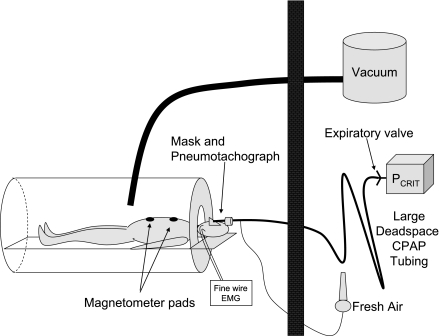Fig. 1.
Experimental setup. Patient lay with his/her body within and head out of the sealed plastic shell in the bedroom. He/she wore a nasal mask/pneumotachograph that was connected to continuous positive airway pressure (CPAP) tubing without an expiratory leak valve but with a fresh air input bleed line in place. To maintain eucapnia, high flow rates of medical air were introduced into the CPAP tubing flushing expiratory gas out of the tubing. However, when hypercapnia was required, the fresh air flow rate could be reduced such that the subjects partially rebreathed their own expired air. Thus the degree of hypercapnia could be maintained throughout changes in CPAP pressure. The subjects also wore magnetometers placed on the chest and abdomen such that changes in EELV, which were induced by applying negative pressure to the sealed chamber, could be documented.

